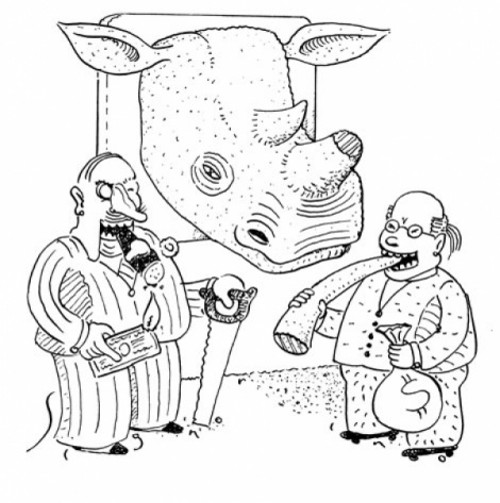You wish. To be fair, you’re not the only one wishing. Optimistic predictions about the possible benefit of Viagra on rhinos and other endangered species have been showing up since 1998. It’s not out of the question that some animals are less at risk. Observed attributable effect on rhinos, however: zip. Why, you ask?
A: Because traditional Chinese medicine (TCM), whose reliance on eye-of-newt-type ingredients gets most of the blame for this sort of thing, doesn’t use rhino horn as an aphrodisiac.
Q: It doesn’t?
A: Nope. That’s a myth perpetuated by Western conservationists and other well-meaning folk—including some scientists, about which more below. While belief that rhino horn will restore failing virility isn’t unknown in Asia, it’s limited to fringe groups in India, Thailand, and Laos.
Q: So why is rhino horn in demand?
A: Because it’s been a TCM mainstay for 2,000 years, used to treat everything from flu to hepatitis. One 16th-century TCM manual recommends rhino horn for typhoid, headache, colds, carbuncles, food poisoning, arthritis, smallpox, and dysentery, although historically the most important use has been fever relief. Impotence, on the other hand, no.
Q: But doesn’t that mean TCM is still the main cause of rhino poaching?
A: Not entirely. Rhino horn is also prized for dagger handles in the Middle East—North Yemen at one time accounted for nearly half of world demand. TCM is a major factor, though. The point is, if you’re a Western scientist who fails to grasp the actual roles various endangered species (or body parts thereof) play in TCM, don’t be surprised when your rosy predictions about the conservation benefits of ED drugs don’t pan out.
Q: What scientists are we talking about?
A: The ones banging the gong the loudest about this have been Frank and William von Hippel. In a 1998 letter to Science, Frank, a biologist, conjectured that Viagra could eliminate demand for “animal potency products.” He wrote, “After all, the cost of Viagra is trivial compared to that of rhino horn.” In a 2002 follow-up, he and his psychologist brother published a table listing nine types of threatened critter “collected for TCM treatments for ED.” The fine print clarified that two of the nine, namely rhinos and tigers, in fact weren’t collected for this purpose. Westerners—apparently including, as of 1998, Frank von Hippel—just thought they were.
Q: So TCM does acknowledge some aphrodisiacs?
A: Oh, sure. They’ve been derived from sea cucumbers, pipefishes, seahorses, geckos, deer, and pinnipeds.
Q: What are pinnipeds?
A: Seals, sea lions, and walruses. I had to look it up too.
Q: Has Viagra taken the pressure off any of these creatures?
A: Difficult to say. Most of the trade in endangered species has been outlawed, so we don’t get market reports. However, indications may be gleaned from the few cases where such dealing remains legal. According to the von Hippels, sales of one TCM aphrodisiac, antler velvet from Alaskan reindeer, dropped sharply following Viagra’s introduction, and the market for seals, prized for their genitalia, collapsed a little later. Critics questioned how much of this was due to competition from ED drugs, but in a 2005 survey underwritten by Pfizer, maker of Viagra, the brothers found Hong Kong men were abandoning TCM impotence treatments, presumably having recognized that modern drugs (a) cost less and (b) actually worked.
Meanwhile, the rhino population, in free fall 20 years ago, has rebounded, but conservation efforts, not pharmaceuticals, have made the difference. What with growing interest in TCM, poaching pressure remains intense.
Q: If they’ve gotten realistic about ED, why are Asians still using nostrums like rhino horn for fever?
A: Why do Westerners buy over-the-counter cold remedies, even though most of them don’t do jack? TCM practitioners for their part swear by rhino horn. For what it’s worth, one scientific study of the stuff claimed it was effective in reducing fever, although only at extremely high doses. If you ask me, the more relevant fact is that for a lot of run-of-the-mill illnesses, you can’t tell if the medicine is doing any good, whether you got it via TCM or Walgreens.
Q: But Western fever remedies, as distinct from cold remedies, are cheap and effective. Why would anybody stick with rhino horn? Would switching to Advil be so tough?
A: Here’s the key, I’m guessing: Therapeutic demand for endangered species is said to be driven not by the Asian masses but rather the affluent business elite, who can afford the exorbitant prices.
Q: So the problem is fat cats infatuated with expensive, unnecessary products?
A: Exactly. Only now it’s cropping up in Asia, too.
Send questions to Cecil via StraightDope.com or write him c/o Chicago Reader, 11 E. Illinois, Chicago 60611. Subscribe to the Straight Dope podcast at the iTunes Store.
More by Cecil Adams
-
This Is the End, My Friend
This week's Straight Dope marks the last appearance of the column as the Teeming Millions have known it for the past 45 years.
- Jul 11, 2018
-
Do Brain Supplements Do Anything?
Brain Drain
- Jul 4, 2018
-
Is flying really worse for the environment than driving?
Planes and Trains
- Jun 27, 2018
- More »




